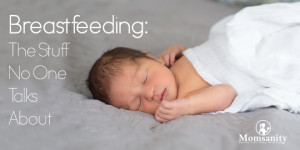Breastfeeding: 10 Things No One Tells You
Apr 10, 2016

By Emily Saunders
This one’s for the new Moms and Moms-to-Be out there. There’s a lot of mom stuff (hello bladder issues) that no one talks about- especially when it comes to breastfeeding. I’m going to start this post by sharing that I am NOT a lactation consultant, mid-wife, doula or anything else that requires training on breastfeeding. I’m just simply going to share my experience and those of my good friends. I’ve been blessed with a strong milk supply and do feel that there are some early practices that can help establish a solid supply for as long as Mom wishes. Each Mom’s experience is different. Some moms can’t breastfeed due to health issues or milk supply problems, while others choose to formula feed from Day 1. While I do advocate breastfeeding for as long as possible for baby’s long term health (supported by research), this post is not intended to be a stance on breastfeeding, but rather informative and encouraging for those who choose to give it a go.

So let’s get started:
- After you give birth it’s important to try to breastfeed as quickly as possible- typically about an hour after birth. Your “milk” won’t be in yet, but baby will enjoy the nutrient rich colostrum that sustains them until it does. It’s really important to stay super duper hydrated during this time. Personally I crave lots of high calorie food during this time and I indulge. Think burgers and fries and smoothies. After the energy expenditure of childbirth my body needs the extra fuel both for recovery and to establish milk supply. P.S. You’ll also feel your uterus contract each time you nurse. This is one of those awesome processes God created to help our bodies heal. It’s uncomfortable, but really important!
- Approximately 24 to 72 hours after giving birth your milk will “arrive”. For most women (especially first time Moms) this can be a crazy experience. The breasts often become engorged and it can be painful. It can also be difficult for baby to latch and/or get any milk out without help. I find that a warm shower, self “massage” while baby is latched and pumping can be helpful to find relief.
- Stock up on coconut oil (for nipple relief), breast milk pads, and good nursing bras or tanks. I didn’t think I really needed this stuff with my first son- boy was I wrong!! Don’t worry about leaky boobs- they’re a fact of life and you’re normal!
- Personally I begin using my breast pump almost immediately. This is controversial, but I much prefer to have an over-supply of milk to not enough. I also feel much less pressure when my husband and family can help feed the baby. I am a huge fan of the Simple Wishes pumping bra (hands free and sturdy) and the Medela Freestyle pump (easy, portable and battery operated- I can pump in the car, while loading the dishwasher and just about anywhere else!)
- I typically recommend that women double their water intake during early breastfeeding. For me this means drinking 2 gallons of water per day. It’s kind of ridiculous, but so very important for establishing a strong milk supply.
- Many times Moms want to begin “dieting” soon after baby is born. Personally, I don’t eat much differently during pregnancy than any other time (first trimester excluded). After baby is born I eat MORE than I do during pregnancy. I would estimate that I eat at least 500 more calories during early-breastfeeding. I don’t eat a lot of extra starches or sugar, but I do eat fattier meats (chicken with skin, more red meat, pork shoulder etc), nuts, avocado, and fruit. My portions of everything are larger. I don’t quit eating because I feel like I’ve had a lot to eat- I quit eating when I stop feeling hungry. I also limit processed foods as much as possible. I pay attention to my cravings. If I crave sugar then I need more starch. If I crave salt I usually need more healthy fats.
I allow my baby to finish on one side completely before moving to the other when nursing so he gets the good “fatty” hind milk. I also alternate “starting” sides to try to help keep milk flow consistent. That said- it’s 100% normal to have more milk on one side than the other.- Your boobs are going to look crazy. They might get a little red at times and will likely be very veiny (yes even your nipples). It’s normal.
- If baby’s latch feels really uncomfortable then it probably needs adjusting. Ask a Mom with multiple kids to help or see a lactation consultant. If you feel a really painful spot on your breast it’s likely a clogged duct. Try pumping until you are completely “dry” or encourage baby to nurse more on that side until it’s relieved. Massaging the area also helps (although it can be really painful in the process).
- If you feel frustrated or in need of support talk to a friend or go see a lactation consultant. Especially if you’re a first time mom breastfeeding might not feel natural or intuitive. It’s a hard skill to learn and each baby will be different.
Lorem ipsum dolor sit amet, consectetur adipiscing elit. Cras sed sapien quam. Sed dapibus est id enim facilisis, at posuere turpis adipiscing. Quisque sit amet dui dui.
Stay connected with news and updates!
Join our mailing list to receive the latest news and updates from our team.
Don't worry, your information will not be shared.
We hate SPAM. We will never sell your information, for any reason.

